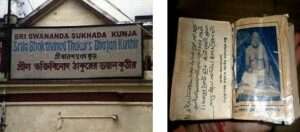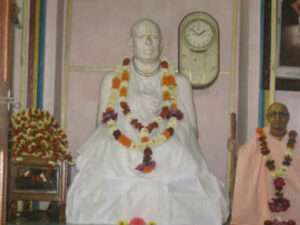Chandan Bhatia: 1. The main altar has a murti of Bhaktivinoda Thakura and his personal Deities, Sri Sri Gauraraga Mahaprabhu and Sri Sri Gadadhara Pandita.
2. On the left side of the main altar is a small place honoring Bhaktivinoda Thakura’s dedicated servant, Krsna dasa.
3. Bhajana Kutira of Gaura-kisora dasa Babaji: the right of the main altar is the place where Gaura-kisora dasa Babajl had a bhajana kutira. He spent many hours chanting here while visiting Bhaktivinoda Thakura.
House: It is on the left side of the property. Bhaktivinoda Thakura’s room is the first room at the top of the stairs. It has some of his personal belongings. This is where he wrote many of his newsletters and books. The verandah outside this room is where Bhaktivinoda Thakura saw the visions of Lord Caitanya in kirtana and the golden city of Mahaprabhu. Bhaktisiddhanta Sarasvatl Thakura’s room is next to his father’s.
Srila Bhaktivinoda Thakura is an eternal associate of Lord Caitanya and his eternal spiritual form is Kamala Manjari. He was born into a wealthy family on 2nd September 1838 in a village named Ulagrama, in the area of Gauramandala. His name was Kedamatha Datta. While still a young boy, he left Ulagrama and moved to his grandfather’s house where he spent most of his youth. After finishing his education, he married and held some teaching positions. He remarried after his first wife died and had several children by his second wife, Srimati Bhagavati Devi, including the acarya, Bhaktisiddhanta Sarasvatt Thakura. Kedarnatha Datta later became a District Magistrate (High Court judge) under the British Government. This was the highest position an Indian could hold under British rule. As the District Magistrate in Puri, he was also overseeing the activities of Lord Jagannatha’s temple. In that position he raised the standard of worship of Lord Jagannatha and also increased the offerings to sixty-four offerings a day.
REVEALING THE DHAMA
Bhaktivinoda Thakura’s desire to be in Navadvipa-dhama was so strong that he resigned his post as Magistrate when the British government refused to transfer him to Krishnagara. At this, the British government conceded and Thakura moved to Godrumadvlpa and became the District Magistrate of Krishnagara. One night, while he was chanting on the verandah of this house, he saw a dazzling golden effulgence emanating from the other side of the Jalangi River (which flows in front of his house).
This also happened the next night, but this time he saw beautiful golden forms of Lord Caitanya and Lord Nityananda dancing in kirtana. The next day, he went searching in the direction of the effulgent vision and came to an area covered in tulasi plants in a Muslim village called Meeyapour. After extensive research and the divine confirmation of Jagannatha dasa Babaji Maharaja, Bhaktivinoda Thakura established that area to be the actual site of Lord Caitanya’s appearance.
In another vision, from the same verandah, Thakura Bhaktivinoda saw the horizon of Mayapur light up under the effulgence of, “One exceedingly wonderful temple which will broadcast the eternal service of Lord Gauranga throughout the world.”‘ The site for this vision was across the Jalangi River on the land where ISKCON has begun plans to build a magnificent temple and city.
To propagate Sri Caitanya Mahaprabhu’s sankirtana mission, Bhaktivinoda Thakura engaged in extensive preaching and writing for many years. Leaving household life, he took babaji initiation from Gaura-kisora dasa Babaji Maharaja. He made plans to go to Vrindavana to end his days there absorbed in the holy name. However, the night before leaving, Krishna appeared to Bhaktivinoda Thakura in a dream and asked him, “Where are you going? You have not yet finished your duty to discover the lost places of My pastimes in Navadvipa dhama.” Fulfilling the Lord’s desire, Thakura Bhaktivinoda stayed in Navadvipa and began extensive research to locate the places of Lord Caitanya’s pastimes. This research culminated in the writing of several books, including the Sri Navadvipa-dhama Mahatmya.
LALITA’S GROVE
Bhaktivinoda Thakura named his house Svananda Sukhada Kunja. It is non-different from Svananda Sukhada Kunja, the private grove of Lalita sakhi located on the bank of Radha-kunda in Vrindavana. Bhaktivinoda Thakura’s songs reveal how he is eternally living in this kunja serving the divine couple, Sri Sri Radha and Krishna. “My small cottage is shining beautifully within that most enchanting garden called Svananda Sukhanda Kunja. Living there I will sing Lord Krishna’s holy name and I will greedily hanker for that time when I will get the service of Him and His associates.” (Gita-mala)
“On the banks of the celestial Ganges, I will dwell in a cottage at Surabhi Kunja in Godruma Dhama. This land of Godruma is very conductive for performing devotional worship of the Supreme Lord and is non-different from the sacred place called Nandagram, located in the holy district of Mathura (Saranagati).”
It is said that at times the four äcäryas, Jagannatha Dasa Babaji Maharaja, Gaura-Kisora Babaji Maharaja, Srila Bhaktivinoda Thakura and Bhaktisiddhanta Sarasvati Thakura, would meet here and discuss the pastimes of Gaurahari.
Relevant resources:
Ulagram- The Birthplace of Srila Bhaktivinoda Thakura: http://mayapur.com/main/?q=node/858
Post view 369 times





Leave a Reply